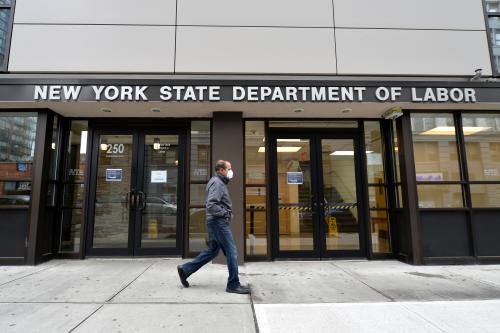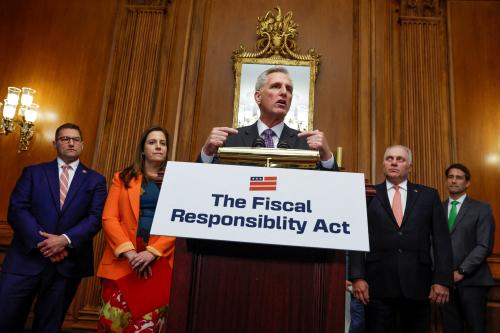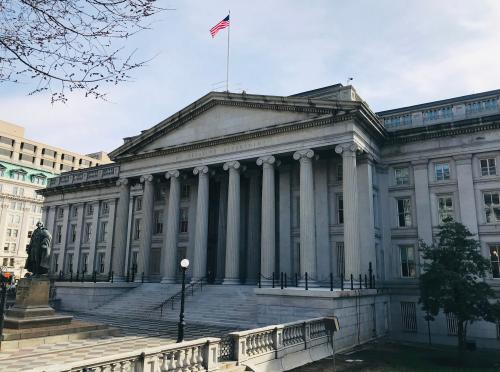Much of the coverage of the Federal Reserve’s review of its monetary policy framework—which culminated in the release of a new statement of its long-term goals—focused on how the Fed would change its approach for achieving one part of its congressional mandate, price stability, which the Fed defined in 2012 as two percent inflation. Indeed, the new statement says that the Fed’s policy committee, the Federal Open Market Committee (FOMC), will now focus on achieving inflation that averages two percent over time, rather than targeting two percent. This makes it explicit that the FOMC will not just allow, but welcome, inflation that exceeds two percent when it has been below target for some time, as it has been lately.
Less expectedly, but perhaps more interestingly, the Fed also announced a change to how the FOMC views the second part of its congressional mandate, the goal of maximum employment. As Fed Chair Jerome Powell said in unveiling the new strategy, “Our revised statement emphasizes that maximum employment is a broad-based and inclusive goal.” He specifically cited the benefits that a strong economy brings to “low- and moderate- income communities.” Moreover, Powell articulated a new strategy for achieving this goal, saying that the FOMC would base policy on the extent to which employment fell short of its maximum level, rather than focusing on whether employment was deviating from its maximum level, as it had in the past.
Although the difference between the strategies is, as Powell said, “subtle,” the revised statement represents a substantial change in how the FOMC has viewed, articulated, and carried out its mission. Advocates for low- and moderate-income communities have argued that the FOMC should provide more accommodative monetary policy well into economic expansions as a way to boost employment among workers in low- and moderate-income communities, often people of color, who are more likely to face unemployment. In response, FOMC members have made the argument that monetary policy is a blunt tool, which is not well suited to aiding specific groups of workers. While it is true that monetary policy cannot target specific workers or industries, these arguments ignore the huge impact that a long economic expansion and low overall unemployment rate has on marginalized workers. The unemployment rate of Black workers is, on average, twice that of white workers, so it takes a prolonged expansion before the unemployment rate of Black workers gets below recession-type levels. Moreover, there is some evidence that the benefits of long expansions disproportionately accrue to workers who are typically disadvantaged in the labor market—that certainly seemed to be the case in the final years of the most recent expansion.
This revised statement acknowledges that the FOMC should take into account the substantial differences in labor market outcomes across communities when thinking about full employment and provides a specific strategy for achieving this. To understand how the new strategy will work, it helps to know how the FOMC thinks about the labor market when setting interest rates. There are two aspects to this process. The first is how the Fed measures employment and the second is how that measure translates into monetary policy.
With respect to measurement, the FOMC’s monetary policy strategy has long noted that it does not set a numerical target for the unemployment rate. This is different from the case of inflation, where it has set the two percent target. Policymakers reason that the FOMC has noted that inflation is largely a monetary phenomenon over which they have significant control. However, full employment is primarily determined not by monetary policy but rather by our demographics, the structure of economy, and other policies over which the FOMC has no control. Moreover, there is no single number that characterizes full employment. That said, the FOMC has often viewed the unemployment rate as the single best indicator for the state of the labor market. But by itself the unemployment rate still doesn’t tell us when we are at full employment. Instead, the Committee has compared the unemployment rate to the natural rate of unemployment, which can be thought of as a rate that prevails if the economy is neither suffering from slack nor overheating. Unfortunately, this is just an estimate; economists don’t know what the natural rate of unemployment is. They typically estimate it by looking at the recent history of the unemployment rate itself and other phenomena, such as employment and inflation. In any case the measurement of the natural rate is extremely imprecise. Statistical models, which can estimate the uncertainty around an estimate of the natural rate, usually indicate that the natural rate can only be known with a good degree of accuracy within two to three percentage points. So, for instance, if the natural rate of unemployment is estimated to be 4.5 percent, it could stand anywhere between three percent and six percent. For this reason, it is not surprising that there is often disagreement among Committee members as to the actual rate.
Then there is the question of how the Fed should use an estimate of the natural rate of unemployment to set interest rates. It is obvious that when the unemployment rate is above its natural rate, the FOMC takes action to spur the economy. This is exactly what they did when the pandemic started and in previous recessions. And it typically keeps policy accommodative until the actual unemployment rate has fallen in line with the natural rate. However, when the unemployment rate falls below the natural rate, the FOMC generally looks to raise interest rates, conditional on the inflation outlook. Why would the FOMC raise rates just because the unemployment rate is below its natural rate? When the unemployment rate is below its natural rate, it suggests that the economy is working above its efficient operating capacity. Historically, this has been an indicator of future inflation, and since monetary policy is forward looking, Fed policymakers take this into account. The overheating could also indicate imbalances elsewhere in the economy—for instance an asset price bubble instead of price inflation. Finally, the overheating of the economy could be detrimental to some workers and firms—for example workers could be working more hours at lower real wages than they expected when they entered into employment contracts, or they could choose to work rather than engage in educational opportunities that boost their long-run earnings prospects. Similarly, firms could have trouble finding workers who are a good fit, reducing productivity, or they could be operating at an unsustainable capacity, which could depreciate their capital and harm their long-run output. Measuring the losses due to these inefficiencies relative to the gains made by workers who are hired as the economy expands is difficult to do.
The change in the policy that Powell articulated is essentially that while the FOMC will still cut interest rates and otherwise set policy to offset a deterioration in labor market conditions, it will no longer raise rates or otherwise remove accommodation just because the unemployment rate is at a low level. In fact, in an acknowledgment of the limitations the natural rate of unemployment as a tool for making monetary policy, both with respect to it measurement and with respect to its ability to summarize the labor market, Powell noted the FOMC will no longer refer to specific estimates of the natural rate in the statement of long-term goals, although it will “continue to report FOMC participants’ estimates of the longer-run level of the unemployment rate,” in the quarterly Survey of Economic Projections.
This new strategy better recognizes the new economic environment and the broad impact that monetary policy has on all members of our society. It acknowledges the benefit of long, strong expansions to low- and moderate-income communities. It is an implicit recognition that the FOMC cannot pinpoint the natural rate of unemployment and that,without obvious signs of overheating in the economy such as inflation, the expansion should be allowed to proceed. Finally, the new strategy is consistent with the evidence that the unemployment rate is no longer as tightly linked to inflation as it was in the past; a low unemployment rate is not by itself a reason to tighten policy in order to ward off future inflation.
The fact that the FOMC was unanimous in approving the statement is significant. The Federal Reserve System is structured so the different regions of our country all have representation on its monetary policymaking committee. This allows for the representation of varied economic interests by region and a diversity of viewpoints. The fact that all members of the Committee came together to approve the new statement indicates a broad understanding of the changes that have taken place in our economy over the past decade or so and a need for the Federal Reserve, as a public institution, if not a democratically elected one, to serve all members of our society.







Commentary
A more inclusive employment mandate
August 28, 2020